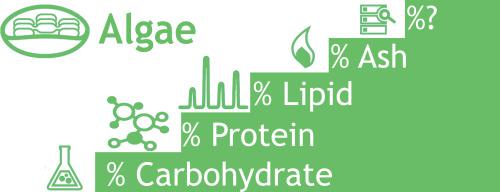Algal Research ( IF 5.1 ) Pub Date : 2020-11-24 , DOI: 10.1016/j.algal.2020.102134 Madeline Lane , Stefanie Van Wychen , Andy Politis , Lieve M.L. Laurens

|
Algal biomass composition is often the primary driver of economic viability of research and commercial algae-based product development. As the commercial algae production field is expanding, there is a growing need for a standardized language across producers and markets in terms of biomass characterization. Similarly, to establish and design collaborative or cross-institutional algae research projects, groups need to harmonize reported compositional analysis data to ensure comparable and reproducible results. In order to provide a consistent foundation of algae quality assessment, we are working towards closely coordinated, harmonized and objective operational protocols across the algae community. We present here a demonstration of biomass composition data from different commercial analytical laboratories, specifically applied to a reference biomass material. The data highlights a lack of consistency across laboratories in methods that are available for analysis. The data presented here illustrate variability in reported biomass measurements of protein, lipids and carbohydrate content causing differences of up to 1.36, 1.43, and 3.37-fold respectively, when expressed on a dry biomass basis. When the same methods are used between the laboratories, e.g. for protein and ash measurements, the data are consistent across laboratories. However, the reported lipid content varies with the method chosen at each laboratory, and causes the calculated carbohydrate content to then absorb the remaining difference from full mass balance closure. A suggestion of a common set of analytical standard methods available commercially is provided and can help to alleviate some of the challenges the algae community faces in terms of biomass descriptive reporting. This work sets the stage for and identifies critical niches to build on an established framework for understanding and harmonizing analytical methodologies for compositional analysis of algal biomass.
中文翻译:

以数据为依据的市售藻类鉴定方法的比较
藻类生物质成分通常是研究和商业藻类产品开发的经济可行性的主要驱动力。随着商业藻类生产领域的扩大,就生物质表征而言,越来越需要跨生产者和市场的标准化语言。同样,要建立和设计协作或跨机构的藻类研究项目,各小组需要协调报告的成分分析数据,以确保结果具有可比性和可重复性。为了提供一致的藻类质量评估基础,我们正在努力在整个藻类社区中密切协调,统一和客观地制定操作规程。我们在此展示了来自不同商业分析实验室的生物量组成数据的演示,特别适用于参考生物质材料。数据突出表明,各个实验室在可用于分析的方法上缺乏一致性。此处提供的数据说明了报告的蛋白质,脂质和碳水化合物含量的生物量测量结果的变异性,当以干生物量为基础进行表达时,分别导致差异高达1.36、1.43和3.37倍。当实验室之间使用相同的方法(例如蛋白质和灰分测量)时,各个实验室的数据是一致的。但是,报告的脂质含量会随每个实验室选择的方法而变化,并导致计算出的碳水化合物含量从质量平衡完全关闭时吸收剩余的差异。提供了可商购的一组通用分析标准方法的建议,可以帮助减轻藻类群落在生物量描述性报告方面面临的一些挑战。这项工作为了解和协调藻类生物质成分分析的分析方法的既定框架奠定了基础,并确定了关键领域。


























 京公网安备 11010802027423号
京公网安备 11010802027423号